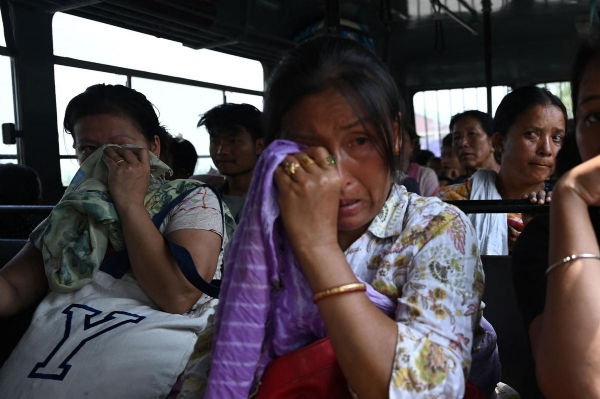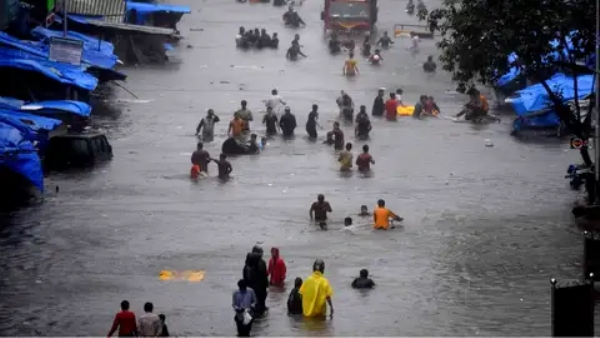#SecurityScan 42: Madhya Pradesh ATS arrested 11 persons and more
General Li emphasized the need for China and Pakistan, described as "all-weather friends," to jointly safeguard their security interests.
Total Views |
This article is a summary of important events that have taken place in last one week affecting, India's national security.
Countering Chinese Multi Domain War
News in Brief

President Murmu confers eight Kirti Chakras, 29 Shaurya Chakras
The President of India has conferred eight Kirti Chakra awards and 29 Shaurya Chakra awards to Indian Armed Forces personnel, Central Armed Police Forces, and state/Union Territory police for their bravery and devotion to duty. Five of the Kirti Chakra and five of the Shaurya Chakra awardees received the accolades posthumously. Sudip Sarkar and Rohit Kumar and others were conferred the Kirti Chakra posthumously while Rifleman Aurangzab and Sepoy Karn Veer Singh were conferred the Shaurya Chakra posthumously.
Left Wing Terrorism, Left Wing Extremism, Maoists, Naxals
3 Maoists killed, policeman injured during exchange of fire in Odisha's Kalahandi on Tuesday.
Railways' bonanza for Agniveers: Reservation in Level-1, Level-2 non-gazetted posts, exemption from physical test, age criteria relaxed
Indian Railways has offered horizontal reservation I various job levels for Agniveers against direct recruitment quota. Agniveers, eligible for exemption from the physical efficiency test, will be given age relaxations and personnel hiring will be administered by railway recruiting agencies, who will recruit staff from the open market against two pay grades.
All recruitment to Army Dental Corps will henceforth be gender neutral:
All recruitment to the Army Dental Corps (ADC) will henceforth be gender neutral and there will be no separate quotas for males and females, the government has told the Supreme court.
China delivers two more new modern naval frigates to Pakistan Navy; Completes four ships order
China has delivered two new Type 054A/P frigates to Pakistan, completing the order of four warships for the Pakistan Navy. Speaking at a joint delivery and commissioning ceremony, the Chief of the Naval Staff of the Pakistan Navy highlighted the ships' state-of-the-art weapons and sensors, including surface-to-surface and surface-to-air missiles, as well as an advanced anti-submarine warfare suite and combat management system.
Department of defence production waives quality assurance charges
"In a significant move to promote reforms and bring ease of doing business, the department of defence production has waived off quality assurance charges levied by the QA agencies under its administrative control for the stores meant for the exports," the ministry said.
Indian, Thai navies carry out coordinated patrol in Andaman Sea
The Indian Navy and the Thai Navy have conducted a coordinated patrol in the Andaman Sea. The patrol which lasted for eight days aimed at keeping the vital part of the Indian Ocean safe for global trade. The two navies have been bi-annually undertaking CORPAT along their international maritime boundary line since 2005.
NIA attaches properties of three Jaish and Hizb men
NIA officials said the agency has intensified its crackdown in Kashmir by attaching the properties of the accused associated with militant organisations and stepping up its vigil against these organisations, their affiliates, agents and overground workers.
Hybrid terrorists linked to new offshoots of Pak-backed terror outfits are involved in collection, distribution of sticky bombs in J-K: NIA
"These cadres and workers are also found to be engaged in the collection and distribution of Improvised Explosive Devices (IEDs), cash, drugs and small weapons, as well as in spreading activities relating to terror, violence and subversion in Jammu and Kashmir," said the Central agency.
16 held for 'links' with radical outfit HUT; MP police say it wanted to topple India's democratic system
The MP ATS arrested 11 persons, including a gym trainer, software engineer and teacher, and booked them under the Unlawful Activities (Prevention) Act (UAPA) and other relevant provisions of the IPC, an official said.
Russia's Wagner boss Prigozhin: Ukrainian offensive has started around Bakhmut flanks
In an audio message posted on his Telegram channel, Yevgeny Prigozhin – the head of Russia's Wagner private army – announced that Ukrainian operations had begun their counterattack and were advancing on Bakhmut from the flanks. The Russian defence ministry said its paratroopers were supporting an advance on the west of the city.
President Xi asks China's submarine force to become elite force to fulfil missions
After he took over power in 2012, Xi, who heads the Central Military Commission, (CMC) - the high command of the PLA - has laid emphasis on developing the Chinese navy in order to increase China's global military presence.
China Warns of ‘Strong’ Reaction If EU Sanctions Its Companies
China would react “strictly and strongly” to any penalties imposed on its companies by the European Union for supplying Russia with so-called dual-use goods that can be used for both military and civilian purposes, according to Foreign Minister Qin Gang.
The EU’s executive arm has proposed extending strict trade restrictions to several Chinese companies as it tries to crack down on firms supplying the Kremlin with banned goods and technologies that have aided its war machine in Ukraine.
South Korean companies increasingly see India as a viable alternative to China
Sustained US-China tensions and other internal and external challenges have pushed South Korea to speed up diversifying its trade and investment
Despite significant hurdles to doing business, India has emerged as an attractive destination for Korean firms such as Samsung, LG and Hyundai
Internal Security
Land of quotas – Manipur is another example of agitation stemming from shrinking land holdings & few regular jobs

Although the demand for inclusion of the Meitei community as Scheduled Tribe is the immediate trigger, the eruption of violence in Manipur has been the result of decades of neglect, discrimination, criminal-political nexus and violent extremism that have led to massive insecurities amongst several indigenous communities. In multiple research we have seen the influx of small arms and light weapons and linkages with narco and human trafficking in this fragile region. The inability to resolve these issues has led to several ethnic groups arming themselves. At one point, Manipur saw the existence of 60 armed groups. Many of us who grew up in the state were caught between the guns of the state and the non-state actors with the situation remaining volatile. However, on this occasion, an emerging structural economic problem appears to have been added to a volatile mix.
Manipur’s Imphal valley, home to Meiteis, covers just about 10% of the state’s territory. However, it’s home to about 67% of the population and also accounts for about 50% of the cultivated area. The hills of Manipur, home to Kukis and Nagas, are largely forested. Forests cover a little over 75% of Manipur. Across that area, hill tribes practise shifting cultivation. In this backdrop, dissonance between two other features of Manipur have put more pressure on pre-existing differences. First, the state has a separate judicial and governance system for the tribal hill areas, which are controlled by Autonomous Hill Councils. Second, these councils are authorised to manage and transfer property.
In Imphal valley, rising population pressure and inadequate economic opportunities created the conditions for Meitei groups to ask for reclassification as Scheduled Tribes. It was a Manipur HC direction last month to the state government to submit a recommendation to GoI on the Meitei demand for reservation that was the immediate trigger for the recent violence. The structural pressure was brought out in GoI’s employment annual report of 2021-22. In Manipur, 42% of the total households are in agriculture. The lack of opportunities is apparent in the data as 60% of the households are categorised as self-employed, a proportion higher than the national average of 54%.
This combination of population pressure on the limited cultivated areas and lack of alternatives has been overlaid on existing ethnic fault lines.
The Meitei demand for ST status is not dissimilar to politically dominant castes in other states seeking a larger share of the reservation pie. The inability of India’s economic transformation to generate adequate decent jobs when land holdings are shrinking is fuelling more social friction. If there’s one challenge that spans states, it’s the inadequacy of economic opportunities for the young.
The situation needs to be defused by lending a sympathetic ear to the tribal population, which is apprehensive that its educational and employment opportunities will shrink once the Meiteis are added to the ST list. At the same time, the wishes and expectations of the Meitei community must be duly taken into account. The state government, in coordination with the Centre, must work out a solution which is acceptable to all groups concerned. Sustainable economic growth and social stability can be ensured though peaceful coexistence of various communities in Manipur.
Personal Security-
Building Resilient Cities: Embracing Action Plans for Extreme Weather
The era of unusual weather patterns has become the norm, ranging from the sudden arrival of summer-like conditions in March to cooler temperatures than usual in May. Although the northern plains have been spared from the scorching heat typically associated with May so far, this trend raises concerns, especially considering the predicted increase in weather fluctuations due to the climate crisis.
Experts fear that intense heat waves and extreme weather events are likely to become more frequent as the planet warms. An extreme heat wave was witnessed in parts of India and Pakistan last year. Between 2031 and 2060, there is a likelihood of mega heat waves; the intensity could double between 2071 and 2100. Studies show that India recorded a 55 per cent rise in deaths due to extreme heat between 2000-2004 and 2017-2021.

The warming of the Arabian Sea is expected to result in intense heat episodes in northwest and central India.
Considering the widespread public safety concerns, a comprehensive heat action plan is now an unavoidable necessity. Cities have to be prepared to minimise damage as entirely new conditions are emerging. The vulnerable population has to be identified, infrastructure readied for emergency situations and awareness campaigns launched to highlight health risks associated with heat exposure.
Corporates and voluntary organisations must be encouraged to install potable water dispensers across towns and cities.
Investment in urban greening is valuable, as is promoting and incentivising sustainable forms of design and building techniques sourced from traditional architecture.
Security Of Tourists and Kerala boat tragedy
The recent tragic sinking of a double-decker boat near a beach in Kerala's Malappuram district has brought attention to multiple security and safety lapses. This incident, resulting in the loss of at least 22 lives, serves as a stark reminder of the rarity of adhering to rules and regulations when engaging in risky tourism activities. The boat was overcrowded and lacked a mandatory safety certificate. Most passengers were without life jackets, and the boat was operating in the waters after sunset, despite a ban on such rides. Neglecting safety guidelines and failing to enforce them has unfortunately become a national trait.
When tragedies like this occur, the immediate response tends to involve ordering investigations, announcing compensation, and attempting to assign blame. However, accountability should not solely rest on the boat owner; it reflects a systemic failure at all levels. One recalls the Morbi bridge collapse in Gujarat last year, with its haunting images still fresh in memory. The incident claimed 141 lives and was an "enormous tragedy."
The selection of a tourist destination is often based on considerations of safety and comfort. A disaster can have long-term negative consequences for a destination, affecting its reputation and visitor numbers. Conversely, it should serve as a catalyst for transformative changes in tour operations. Mitigation, preparedness, response, and recovery guidelines should not be mere decorative words on a signboard that tourists overlook. Both soft and hard measures must be strictly enforced in tourist areas. Harsh penalties should be imposed on organizers and tourists who violate regulations, licenses should be suspended, and regulatory teams held accountable for lax supervision. Implementing these measures should not be an insurmountable challenge.
Tourism is a significant economic activity that generates employment on a large scale. Adhering to a code of conduct is essential to mitigate risks. When preventable calamitous events recur, it demonstrates our unwillingness to learn from past mistakes and make necessary improvements.
Economic Security
Doval’s Riyadh visit and I2U2’s steady progress demonstrate pragmatic and business-like foreign policy
Over the past decade, India has invested considerable energy in its relations with UAE, Saudi Arabia and Israel through separate strategic partnership agreements and is now in a good position to participate in the geoeconomics opportunities being created by the shifting geopolitics in the region. The visit of NSA Ajit Doval to Riyadh and the steady progress being made by the I2U2 demonstrate a nimble, pragmatic and business-like foreign policy that will yield positive outcomes. The addition of Saudi Arabia to the mix and the presence of Sheikh Tahnoun bin Zayed, UAE’s influential NSA in Riyadh, are vital developments for the connectivity project because of concerns in the UAE about trade restrictions being imposed by the Saudis on goods coming from the emirates.
The connectivity project would be a positive development on its own steam. It should it be seen as an attempt to undermine the Chabahar or Bandar Abbas connectivity projects via Iran. Each one of these has its own place in the geoeconomics of the region and each can stand on its own if it delivers on its promise.
India’s Energy security
Strengthening India's civil Nuclear Program for Sustainable Future Energy Needs
Twenty-five years ago, on this day India conducted nuclear tests in Pokhran .The Defence Minister of India, Rajnath Singh, has stated that the country's nuclear testing in 1998 demonstrated that while India is a peaceful country, it will defend its integrity, unity and sovereignty at all costs. The tests, conducted between May 11 and 13 in Rajasthan's Pokhran desert, allowed India to join the select group of nations capable of developing nuclear weapons.
To put these tests in perspective, note nuclear technology is dual use in nature. Therefore, the international efforts to curb weapons proliferation takes a toll on civil nuclear effort. Hence, India’s Pokhran detonations can be understood in the context of the civil nuclear effort.
In the 1960s when India embarked on civil nuclear plants to generate electricity, it had to weigh trade-offs. Uranium supplies were limited but thorium was abundant. It wasn’t possible to build a reactor using thorium at the outset. Therefore, India opted for pressurised heavy water reactors (PHWRs) with uranium and a closed fuel cycle – spent fuel is reprocessed and partly reused. It was designed as the first stage.
The second stage would be to recover enough plutonium through reprocessing from functioning PHWRs and generate plutonium-uranium fuel for fast breeder reactors – there’s a prototype in Kalpakkam.
It’s only in the third stage, once there’s an adequate inventory of plutonium, advanced reactors using thorium come in. This grand plan was short-circuited by the fallout of Pokhran-I as trade bans squeezed India’s uranium supply.

India-US civil nuclear cooperation in 2008 was important. It was followed by the Nuclear Suppliers Group agreement soon and a 34-year curb on uranium supply to India ended. Today, Canada and Kazakhstan are among the main suppliers of natural uranium ore to our reactors under IAEA safeguards.
India realised its military aims out of two episodes of nuclear detonations spread over 25 years. That was right . But on the civil side, at 6780 MW, nuclear power is just 1. 6% of installed power capacity. It’s time to move fast here as the geopolitical situation is favourable and nuclear energy remains an important source of non-fossil fuel. India now needs to deliver on its target of 10 new 700 MW PHWRs by 2031.
External Security
Pakistan’s Descent Into Anarchy and Civil War
After Imran Khan's arrest, the ongoing crisis in Pakistan has reached a critical point, posing a systemic challenge for the country. Khan's apprehension by the paramilitary Rangers at the Islamabad high court was a clear message that he had crossed a red line by criticizing Pakistan's military-security establishment. Despite this, Khan has garnered immense popularity, making him the most influential Pakistani leader in over a decade. His refused to conform to the army's hybrid regime.
As protests led by Khan's PTI supporters spread, the hybrid regime is facing its toughest trial yet. The Shehbaz Sharif government, aiming to undermine Khan's political momentum as legal cases accumulate against him, seeks to postpone the scheduled national elections. However, if the protests persist, army chief Asim Munir will be confronted with a difficult choice: either intervene directly and take control or jeopardize the military's dominant position in Pakistani society. For decades, the generals have played a stabilizing role in Pakistan, albeit with messy outcomes.
Nonetheless, orchestrating another military takeover in today's geopolitical climate would be precarious. Pakistan's relevance in international politics has diminished significantly, particularly after the US withdrawal from Afghanistan. While China remains a supportive benefactor through its CPEC projects, this support aligns with Beijing's strategic and mercantile interests. Without US backing, a Pakistan governed by the military would likely be isolated from vital IMF bailouts necessary for its struggling economy. Foreign exchange reserves remain insufficient, inflation is rising, and the population is enduring widespread hardship.
Therefore, General Munir will strive to sustain the hybrid regime, possibly allowing the protests to continue until demands for more significant intervention emerge. Nevertheless, popular movements are inherently unpredictable.
The army faces a stark choice. Most analysts believe the days when generals such as Zia-ul-Haq and Pervez Musharraf removed civilian governments are over, and the military has shifted to a role where it can manage the government by remote control. However, the army’s deepening unpopularity and experience with Mr Khan indicate that a hybrid regime is unworkable. Since the days of General Ashfaq Pervez Kayani, who replaced Musharraf, several Pakistan Army chiefs have spoken of steering clear in politics. But with its interests and influence over Pakistan’s destiny at stake, it will be tough for the current chief, General Asim Munir to walk the talk on this promise. In a country wrecked by a floundering economy and escalating terror strikes from the Tehreek-e-Taliban Pakistan, his next steps will be key.
Latest MiG-21 crash is undermining IAFs defence preparedness
The IAF has three MiG-21 squadrons with a total of around 50 aircraft, which have been involved in around 400 crashes since their first induction in the early 1960s.The latest MiG-21 crash has killed three civilians and injured three more – wreckage from the burning aircraft fell on a village home in Rajasthan. The inglorious history of MiG-21 crashes in this country is a tragedy. The Russian aircraft, of 1960s vintage, should have been phased out decades ago. That three squadrons of the MiG-21 continue to be in service is dangerous.
It is shocking that 55 military personnel have lost their lives in more than 50 aircraft and helicopter accidents in just over five years. The MiG-21 as well as the Cheetah/Chetak helicopters have been major culprits. Far from ensuring India’s military capabilities, these flying coffins have become weapons against the armed forces themselves. The MiG-21s are supposed to be replaced by the indigenous Tejas fighter. But the latter’s low rate of production and induction has meant that less than 40 are in service against an order of 123. This gap is precisely why the MiGs continue to fly despite lack of modern avionics and poor spare parts.
The number of fighter squadrons is down to 31 as against a sanctioned strength of 42. Add to this serviceability issues and the actual number of fighters at our disposal at a given time is even fewer. True, the induction of 36 Rafale fighters has boosted airpower in per aircraft terms. But absolute numbers matter – since India must always prepare for a two-front war across a vast land and sea border.
Russian air forces poor performance in the Ukraine war has already raised serious concerns in India. Plus, that war itself has jammed up the supply of spares as well as the proposed $2. 2 billion deal for the purchase of additional MiG-29s and Su-30 MKIs by India. Diversify the procurement programme, speed up indigenous production and phase out the remaining MiG-21s well before the 2025 deadline is the only way ahead
Countering China’s Naval Grey Zone War -India’s military engagement with ASEAN riles Beijing
While India has sent warships to the South China Sea in the past as well, this was the first such naval exercise with the ASEAN grouping. Navy Chief Admiral R Hari Kumar had inaugurated the exercise along with Rear Admiral Sean Wat, Chief of Navy, Republic of Singapore Navy.

China's growing unease with India's strengthening military alliances is evident as it attempts to disrupt the inaugural ASEAN-India Maritime Exercise (AIME-23) in the South China Sea. Chinese maritime militia boats approached the exercise area, where the navies of India and ASEAN countries were conducting drills, potentially aiming to intimidate or disrupt the participants. Fortunately, the exercises concluded smoothly, and Indian warships INS Delhi and INS Satpura proceeded to their new destination in the region. These militias, believed to work in coordination with Chinese authorities, highlight China's objection to AIME-23, which seeks to promote maritime cooperation and build trust among participating countries.
China's reaction to AIME-23 follows its sharp response to the India-US military exercise held near the Line of Actual Control (LAC) last year, where Beijing claimed it violated the spirit of border agreements with India. However, China's own compliance with these agreements has been questionable. Defense Minister Rajnath Singh recently conveyed to his Chinese counterpart, General Li Shangfu, that China's violations have undermined the foundation of bilateral ties between the two countries.
China's provocative actions coincide with the visit of Pakistan's naval chief, Amjad Khan Niazi, to Beijing. China is providing extensive support to Pakistan in its naval modernization efforts, including the supply of eight submarines and four naval frigates. General Li emphasized the need for China and Pakistan, described as "all-weather friends," to jointly safeguard their security interests. Consequently, India faces multiple threats from its hostile neighbors, necessitating the strengthening of its military capabilities and preparedness to counter any potential misadventures.
Russia Ukraine War
US to provide Ukraine $1.2 billion in long-term security aid
The US is providing Ukraine $1.2bn in long-term military aid to boost its air defences and deter Russian aggression, according to the Pentagon. The package includes air-defence munitions, drones, howitzer ammunition, satellite imagery assistance and funding for maintenance and spare parts. The aid will enhance Ukraine’s air defences, including modifying Western air-defence launchers to use with Ukraine’s systems and reportedly includes weapons such as HAWK air-defence systems.
The International Fund for Ukraine, consisting of Britain, Norway, the Netherlands, Denmark and Sweden, has posted a call for expressions of interest from companies to supply Ukraine with missiles with a range of up to 300 km. The missiles should be capable of being launched from land, sea, or air with a payload of between 20 and 490 kg and require "low probability of intercept" and "air defence penetration methods".
--


